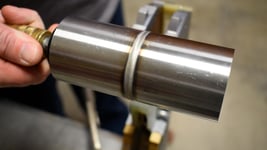How Welders Use Purge Plugs to Purge Gases Out of Stainless-Steel Workpieces
With purge welding, operators can create stainless steel welds that are both aesthetically pleasing and structurally strong. And as with any type of welding, using the right tools will make the job go more smoothly and result in better results. In this post, we’ll go through how welders can use purge plugs to purge atmospheric gases out of stainless-steel workpieces so they can achieve better results while working with this material. Let’s take a look at what purge plugs are and how they help with orbital welding.
What are purge plugs?
Purge plugs are the vital components of gas tungsten arc welding (GTAW) and orbital welding. High-quality plugs are manufactured from Daruvar-Ultra High Molecular Polyethylene, designed to withstand high welding temperatures. Purge plug sets are made from 2 main components, the plug, and the exhaust. The plug has an external quick-connect gas fitting to push the purging gas of choice and internal gas diffusers to quickly distribute gas evenly through the workpiece. The exhausts have an exhaust that is used to purge gases from the weld zone, purging out all the oxygen and replacing it with argon. Orbital welding usually uses argon as its shielding gas, but other gases like Helium, CO2, Hydrogen or Nitrogen can also be used as well. In orbital welding, purge plugs can also help protect the weld pool from contamination by oxygen in the air.
What gases do they remove?
Purge gases shield weld pools from oxygen and nitrogen in the air. As stated above, MIT recommends using argon for orbital welds, as we have seen it delivers the cleanest and most consistent welds compared to other shield gases. When the purge plugs are inserted into the workpiece, the argon fills the interior, exhausts the gases that can cause discoloration, and shields the electrode from atmospheric gases. As a result, purging creates strong clean sanitary welds.
How long should I purge my weld?
The amount of time it takes to purge depends on the weld application. We tested different time frames in our weld lab and came up with some interesting results.
We tested 4 typical purge plug methods to see which one worked the best on .065" stainless steel tubing.

Test 1
When we tested a pre-purge (before the weld) of 0 seconds and a post-purge (after the weld) of 0 seconds, we observed severe discoloration, bubbling, and some sugaring on the I.D. and O.D. of the workpiece
Test 2
Our second test was 15 seconds for both pre-purge and post-purge and delivered a test weld with about 25% less discoloration, no bubbling, and no sugaring.
Test 3

The third test ran a 30-second pre-purge and a 60-second post-purge. The 60 post-purge delivered the best results with almost no discoloration, no bubbling, no sugaring, and no gaps anywhere inside or outside the workpiece.
Test 4
The final test we ran was 60-second pre-purge and a 120-second post-purge and showed the exact same results as the 30/60 test. All-in-all, we would recommend using the 30/60 method as it delivers the best results possible while keeping your orbital welding efficient.
(All these test run with an AMI 8-2000 weld on a 2" Stainless Steel Tube .065" wall thickness, your results may vary)
What are the benefits of using purge plugs?
There are three big benefits to using a purge plug kit. First, purge plugs are not just a safety measure: they also let welders purge gases out of stainless-steel workpieces creating better quality welds. Second. without purge plugs, atmospheric gases would build up inside the workpiece and cause bubbles or sugaring that could damage the weld and force the welder to rework the piece. Sugaring is the process of oxidation on the back of your weld, which often looks like a splatter of granulated. Third, using purge plugs reduces costs by providing welders with a reusable solution that is virtually indestructible.
There are three big benefits to using a purge plug kit. First, purge plugs are not just a safety measure: they also let welders purge gases out of stainless-steel workpieces creating better quality welds. Second. without purge plugs, atmospheric gases would build up inside the workpiece and cause bubbles or sugaring that could damage the weld and force the welder to rework the pice. Sugaring is the process of oxidation on the back of your weld, which often looks like a splatter of granulated. Third, using purge plugs reduces costs by providing welders with a reusable solution that is virtually indestructible.
Nov 7, 2022 11:47:18 AM



.png)
Comments